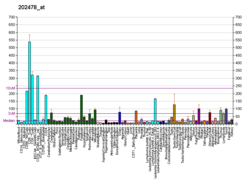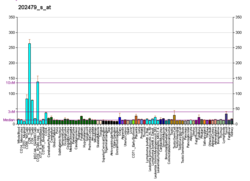트리블스 호몰로지 2 는 TRIV2 유전자 에 의해 인간으로 부호화된 비정형 단백질 키나아제 다.[5] [6] [7] [8] TRIV2는 신호/스캐폴드 단백질의 (pseudoenzyme ) 부류의 가성질 성분으로 체외에서 거의 전정 촉매 출력을 가지고 있지 않다.[9] 표준 MAPK 경로에 신호를 보내고 면역체계의 중요한 기능을 가진 기판의 편재성을 조절하는 것으로 알려져 있다. 또한 다양한 질병, 특히 척추동물 백혈병 모델에서 연관되어 왔다.[10] TRIV1 , TRIV3 와 마찬가지로 TRIV2는 최근 잠재적 위상 약물 표적으로 고려되고 있으며 AKT pSer473 변조를 통해 암 관련 신호 전달 및 생존을 조절하는 역할을 하고 있다.[11] [12]
참조 ^ a b c GRCh38: 앙상블 릴리스 89: ENSG000071575 - 앙상블 , 2017년 5월^ a b c GRCm38: 앙상블 릴리스 89: ENSMUSG000020601 - 앙상블 , 2017년 5월^ "Human PubMed Reference:" . National Center for Biotechnology Information, U.S. National Library of Medicine .^ "Mouse PubMed Reference:" . National Center for Biotechnology Information, U.S. National Library of Medicine .^ Wu M, Xu LG, Zhai Z, Shu HB (Jul 2003). "SINK is a p65-interacting negative regulator of NF-kappaB-dependent transcription" . J Biol Chem . 278 (29): 27072–9. doi :10.1074/jbc.M209814200 PMID 12736262 . ^ ^ Hegedus Z, Czibula A, Kiss-Toth E (Aug 2006). "Tribbles: novel regulators of cell function; evolutionary aspects". Cell Mol Life Sci . 63 (14): 1632–41. doi :10.1007/s00018-006-6007-9 . PMID 16715410 . S2CID 24556931 . ^ "Entrez Gene: TRIB2 tribbles homolog 2 (Drosophila)" .^ Bailey FP, et al. (2015). "The Tribbles 2 (TRB2) pseudokinase binds to ATP and autophosphorylates in a metal-independent manner" . Biochemical Society Transactions . 467 (1): 47–62. doi :10.1042/BJ20141441 . PMC 4844368 PMID 25583260 . ^ Eyers PA, Keeshan K, Kannan N (2016). "Tribbles in the 21st Century: The Evolving Roles of Tribbles Pseudokinases in Biology and Disease" . Trends in Cell Biology . 27 (9): S0962-8924(16)30178-7. doi :10.1016/j.tcb.2016.11.002 . PMC 5382568 PMID 27908682 . ^ Foulkes DM, Byrne DP, Eyers PA (2015). "Tribbles pseudokinases: novel targets for chemical biology and drug discovery?". Biochemical Society Transactions . 43 (5): 1095–1103. doi :10.1042/BST20150109 . PMID 26517930 . ^ Byrne DP, Foulkes DM, Eyers PA (2017). "Pseudokinases: update on their functions and evaluation as new drug targets" . Future Medicinal Chemistry 9 (2): 245–265. doi :10.4155/fmc-2016-0207 PMID 28097887 . ^ Hill R, Madureira PA, Ferreira B, Baptista I, Machado S, Colaço L, Dos Santos M, Liu N, Dopazo A, Ugurel S, Adrienn A, Kiss-Toth E, Isbilen M, Gure AO, Link W (2017). "TRIB2 confers resistance to anti-cancer therapy by activating the serine/threonine protein kinase AKT" . Nature Communications . 8 (5): 14687. doi :10.1038/ncomms14687 . PMC 5347136 PMID 28276427 . 추가 읽기 Strausberg RL, Feingold EA, Grouse LH, et al. (2003). "Generation and initial analysis of more than 15,000 full-length human and mouse cDNA sequences" . Proc. Natl. Acad. Sci. U.S.A . 99 (26): 16899–903. doi :10.1073/pnas.242603899 PMC 139241 PMID 12477932 . Kiss-Toth E, Bagstaff SM, Sung HY, et al. (2004). "Human tribbles, a protein family controlling mitogen-activated protein kinase cascades" (PDF) . J. Biol. Chem . 279 (41): 42703–8. doi :10.1074/jbc.M407732200 PMID 15299019 . S2CID 25829757 . Gerhard DS, Wagner L, Feingold EA, et al. (2004). "The status, quality, and expansion of the NIH full-length cDNA project: the Mammalian Gene Collection (MGC)" . Genome Res . 14 (10B): 2121–7. doi :10.1101/gr.2596504 . PMC 528928 PMID 15489334 . Hillier LW, Graves TA, Fulton RS, et al. (2005). "Generation and annotation of the DNA sequences of human chromosomes 2 and 4" . Nature . 434 (7034): 724–31. doi :10.1038/nature03466 PMID 15815621 . Zhang Y, Davis JL, Li W (2005). "Identification of tribbles homolog 2 as an autoantigen in autoimmune uveitis by phage display". Mol. Immunol . 42 (11): 1275–81. doi :10.1016/j.molimm.2004.11.020 . PMID 15950723 . Lim J, Hao T, Shaw C, et al. (2006). "A protein-protein interaction network for human inherited ataxias and disorders of Purkinje cell degeneration" . Cell . 125 (4): 801–14. doi :10.1016/j.cell.2006.03.032 PMID 16713569 . S2CID 13709685 . Lin KR, Lee SF, Hung CM, et al. (2007). "Survival factor withdrawal-induced apoptosis of TF-1 cells involves a TRB2-Mcl-1 axis-dependent pathway" . J. Biol. Chem . 282 (30): 21962–72. doi :10.1074/jbc.M701663200 PMID 17545167 .








